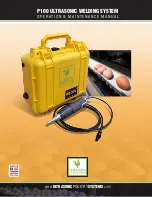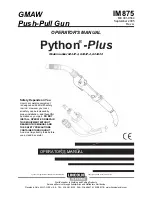
2 Prevention of Electro Static Discharge (ESD) to
Electrostatically Sensitive (ES) Devices
Some semiconductor (solid state) devices can be damaged easily by electricity. Such components commonly are called
Electrostatically Sensitive (ES) Devices. Examples of typical ES devices are integrated circuits and some field-effect transistors and
semiconductor “chip” components. The following techniques should be used to help reduce the incidence of component damage
caused by electro static discharge (ESD).
1. Immediately before handling any semiconductor component or semiconductor-equiped assembly, drain off any ESD on your
body by touching a known earth ground. Alternatively, obtain and wear a commercially available discharging ESD wrist strap,
which should be removed for potential shock reasons prior to applying power to the unit under test.
2. After removing an electrical assembly equiped with ES devices, place the assembly on a conductive surface such as aluminium
foil, to prevent electrostatic charge build up or exposure of the assembly.
3. Use only a grounded-tip soldering iron to solder or unsolder ES devices.
4. Use only an anti-static solder remover device. Some solder removal devices not classified as “anti-static (ESD protected)” can
generate electrical charge to damage ES devices.
5. Do not use freon-propelled chemicals. These can generate electrical charges sufficient to damage ES devices.
6. Do not remove a replacement ES device from its protective package until immediately before you are ready to install it. (Most
replacement ES devices are packaged with leads electrically shorted together by conductive foam, aluminium foil or
comparable conductive material).
7. Immediately before removing the protective material from the leads of a replacement ES device, touch the protective material
to the chassis or circuit assembly into which the device will be installed.
Caution
Be sure no power is applied to the chassis or circuit, and observe all other safety precautions.
8. Minimize body motions when handling unpackaged replacement ES devices. (Otherwise harmless motion such as the brushing
together of your clothes fabric or the lifting of your foot from a carpeted floor can generate static electricity (ESD) sufficient to
damage an ES device).
6
SC-EN37P
Summary of Contents for SC-EN37P
Page 10: ...6 Accessories Remote Control AC Cord FM AM Antenna I Pod cradle 10 SC EN37P ...
Page 12: ...7 3 Connection 12 SC EN37P ...
Page 30: ...11 1 Check and Repair of CD Servo P C B 30 SC EN37P ...
Page 33: ...12 2 CD Servo P C B 12 3 Motor P C B 12 4 Panel P C B 12 5 Tuner P C B 33 SC EN37P ...
Page 34: ...12 6 Waveform Chart 34 SC EN37P ...
Page 35: ...13 Wiring Connection Diagram 35 SC EN37P ...
Page 36: ...SC EN37P 36 ...
Page 37: ...14 Block Diagram 14 1 CD Servo SC EN37P 37 ...
Page 38: ...14 2 Tuner SC EN37P 38 ...
Page 39: ...14 3 Main 1 2 Transformer Sensor D Port SC EN37P 39 ...
Page 40: ...14 4 Main 2 2 Panel LED Power Switch Tact Switch Switch Motor SC EN37P 40 ...
Page 42: ...42 SC EN37P ...
Page 44: ...16 1 A CD Servo Circuit SC EN37P 44 ...
Page 45: ...16 2 B Tuner Circuit SC EN37P 45 ...
Page 46: ...16 3 C Main Circuit SC EN37P 46 ...
Page 47: ...SC EN37P 47 ...
Page 48: ...SC EN37P 48 ...
Page 49: ...16 4 D Panel Circuit E D Port Circuit SC EN37P 49 ...
Page 50: ...16 5 F LED Circuit G Power Switch Circuit H Tact Switch Circuit I Switch Circuit SC EN37P 50 ...
Page 51: ...16 6 J Motor Circuit K Sensor Circuit L Transformer Circuit SC EN37P 51 ...
Page 52: ...SC EN37P 52 ...
Page 54: ...SC EN37P 54 17 2 C Main P C B ...
Page 58: ...SC EN37P 58 ...
Page 59: ...18 Illustration of ICs Transistors and Diodes 59 SC EN37P ...
Page 61: ...20 Exploded Views 20 1 Cabinet Parts Location SC EN37P 61 ...
Page 62: ...SC EN37P 62 ...
Page 63: ...20 2 Packaging SC EN37P 63 ...
Page 64: ...SC EN37P 64 ...







































